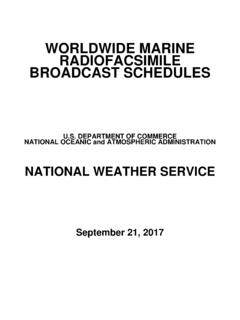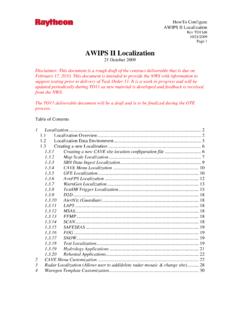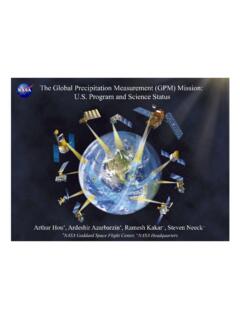Transcription of NATIONAL WEATHER SERVICE INSTRUCTION 10-1302 …
1 Department of Commerce NATIONAL Oceanic & Atmospheric Administration NATIONAL WEATHER SERVICE NATIONAL WEATHER SERVICE INSTRUCTION 10-1302 . APRIL 20, 2018. Operations and services Surface Observing Program (Land), NDSPD 10-13. REQUIREMENTS AND STANDARDS FOR NWS CLIMATE OBSERVATIONS. NOTICE: This publication is available at: OPR: W/OBS31 (T. Trunk) Certified by: W/OBS3 (M. Miller). Type of Issuance: Routine SUMMARY OF REVISIONS: This directive supersedes NWSI 10-1302 , Requirements and Standards for NWS Climate Observations, dated, Nov 14, 2014. Changes made reflect the NWS. Headquarters reorganization effective April 1, 2015. Changed all references to NATIONAL Climatic Data Center to NATIONAL Centers for Environmental Information and NCDC to NCEI to reflect the new name. Joseph A. Pica Date Director, Office of Observations NWSI 10-1302 APRIL 20, 2018. Requirements and Standards for NWS Climate Observations Table of Contents: Page 1.
2 Introduction 5. 2. Cooperative Observing Program Observations ..5. Site and Exposure Standards . 6. Air Temperature Measurement .. 7. Precipitation Gauges .. 7. 3. Air Temperature . 8. Measurement Performance .. 8. Test and Evaluation .. 9. Time Constant .. 10. General Instruments . 10. Hardened Instruments .. 10. Air Temperature Data 11. WFO Generated Products .. 12. 4. Precipitation .. 13. Daily Precipitation Observation ..13. Daily Data and Reporting Standard . 15. Snow Measurement .. 16. Snow Depth Observation . 16. Hourly Precipitation Data Observation ..18. Monthly Data and Reporting Standard 18. Electronic Logging Gauges ..18. WFO Generated Products ..20. 5. Soil Temperature . 20. Soil Temperature Measurement Performance 20. Data Requirement .. 21. WFO Generated Products .. 22. 2. NWSI 10-1302 APRIL 20, 2018. 6. Pan Evaporation .. 23. Evaporation Pan Standards 23.
3 Required Observations .. 24. Maximum and Minimum Water Temperature of Last 24 Hours 24. Maximum and Minimum Air Temperature of 24 Hours ..24. Precipitation Accumulation of Last 24 Hours .25. Air Movement of Last 24 Hours ..25. WFO Generated Products ..27. 7. Metadata for Cooperative Observations ..28. 8. NOAA Distributed Data ..28. 3. NWSI 10-1302 APRIL 20, 2018. List of Tables: Page Performance Standards Air Temperature Measurements ..9. Data Requirements for Air Temperature .11. WFO Products Containing Air Temperature ..12. NOAA Datasets Containing Air Temperature Data .. 13. Gauge Standard for Manually Observed Precipitation .. 14. Data Standard for Manually Observed Daily Precipitation 15. Equipment Standard for Snow Depth . 16. Data Standard for Snow Measurement .. 17. Measurement Requirements for Recorded Precipitation 17. Data Requirements for Recorded Precipitation.
4 18. WFO Products Containing Precipitation Data 19. NOAA Datasets Containing Precipitation Data and Observed Snow Data 19. Measurement Standards for Soil Temperatures .. 21. Data Requirements for Soil Temperature .. 22. WFO Products Containing Soil Temperature Data 22. Web Based Datasets and Publications Containing Soil Temperature Data 23. Observation Requirements for Pan Evaporation 24. Performance Standards for Water Temperature Measurements . 25. Performance Standards for 24-Hour Air Movement Measurements .. 26. WFO Products Containing Pan Evaporation Data . 26. Web Based Datasets and Publications Containing Pan Evaporation Data . 27. 4. NWSI 10-1302 APRIL 20, 2018. 1 Introduction This INSTRUCTION describes the requirements and standards for NATIONAL WEATHER SERVICE (NWS). meteorological climate observations. The standards are for instrument siting, exposure, performance, and output data for temperature, precipitation, soil temperature, and evaporation.
5 If standards cannot be met by the equipment in place, then the standards should be achieved when stations are changed, equipment is installed, programs are modified, or new stations are established. The standards for instrument performance, exposure, and data output in this INSTRUCTION will support the recommendations of the World Meteorological Organization (WMO) for a climate observing program. As new instruments are introduced, studies to determine adjustment factors to account for differences between old and new instruments, gauges, and shelters are made. For further information, see Intercomparison of Hydrometeorological Instruments and Algorithms, which is the NWS Policy Directive NWSPD 10-21. The goal is to preserve the temporal continuity of station databases and make the change as seamless as possible in terms of the official climate record. The initiator of the change will be responsible for managing the studies.
6 The results of the study will be documented and changes included in the station history file. 2 Cooperative Observing Program Observations This section outlines the types of instruments in use by the Cooperative Observing Program (COOP). The NWS COOP station equipment can be the property of the NWS, the observer, a company, or any other government agency. New equipment installed at a COOP site is required to meet the site exposure requirements defined in Section 3 of this INSTRUCTION , as well as in NATIONAL WEATHER SERVICE manual (NWSM) 10-1315, Cooperative Station Observations and Maintenance. Photos and descriptions of observing equipment are found in NWSM 10-1315, Appendices A and B. Access the manual from the NWS directives website: 5. NWSI 10-1302 APRIL 20, 2018. Climate observing programs may meet their data requirements with these or other instruments. 1. Maximum / Minimum Air Temperature Instruments 2.
7 Standard Rain Gauges (Non-recording). 3. Recording Rain Gauges 4. Snow Sticks, Snow Measurement Boards, and Snow Stakes 5. Maximum / Minimum Soil Temperature Instruments 6. Pan Evaporation Instruments 7. Wind Run Anemometers 8. Maximum / Minimum Water Temperature Instruments The minimum standards for producing the required observations in the Aviation Observing Program are described in NWS INSTRUCTION (NWSI) 10-1301, Aviation and Synoptic Observations, located at: 3 Site and Exposure Standards This section provides instrument siting and exposure standards for the Cooperative Observing Program. Policies for how to establish cooperative sites, collect and distribute observations, conduct site visits and manage the stations are outlined in NWSI 10-1307, Cooperative Program Management and Operations, found at: Standards in document will be followed as closely as possible to ensure uniformity of observations to meet NATIONAL and international climatic observation requirements.
8 Site and exposure standards define and establish specifications and guidelines. The implementation of these should be flexible to achieve a balance between meteorological representativeness, space availability, and cost effectiveness. Site and exposure standards differ between the aviation and climate programs. The Office of Federal Coordinator for Meteorology (OFCM) details the site and exposure standards as they apply to federal and non-federal observers. See FCM-S4-1994, Federal Standard for Siting Meteorological Sensors at Airports (Washington, DC, 1994), accessible on: (Siting).pdf Instruments are not to be sited on rooftops. Relocation of instruments will be accomplished as funds permit and after coordination with Regional Headquarters. In a small number of cases, it is desirable to maintain the rooftop sitting in order to maintain the historical climate record.
9 The NATIONAL Centers for Environmental Information (NCEI) will provide a waiver for the continued maintenance of existing rooftop stations. 6. NWSI 10-1302 APRIL 20, 2018. Air Temperature Measurement Install the temperature instrument according to the following standards: 1. Over level terrain (earth or sod) typical of the area around the station, and, at least 100 feet from any extensive concrete or paved surface. 2. All attempts will be made to avoid: 1) areas where rough terrain or air drainage are proven to result in non- representative temperature data;. 2) Areas where water tends to collect; and 3) areas where drifting snow collects. 3. If the instrument is within a Cotton Region Shelter, or equivalent, position the shelter so it opens to the north, in the northern hemisphere (to protect the instruments from direct sun exposure) with the floor 4 to 6 feet above the surface.
10 Shelters should be located no closer to an obstruction than four times the height of the obstruction. 4. In the case of remote instruments not enclosed in shelters, the instrument (and display, if configured) will be mounted 4 to 6 feet above the surface and shielded by an integral thermoscreen. Remote instruments should be located no closer to an obstruction than four times the height of the obstruction. 5. An object will be considered an obstruction if the object is greater than ten degrees in horizontal width as measured from the instrument and within 200. feet of the instrument. The instrument should be no closer than four times the estimated height of any nearby building, tree, fence, or similar obstruction. Precipitation Gauges The exposure of precipitation gauges is of primary importance in the accuracy of precipitation measurements. An ideal exposure would eliminate all turbulence and eddy currents near the gauge that tend to carry away the precipitation.







